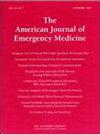Identifying mobility instruments used in emergency departments and evaluating their measurement properties: A systematic review
IF 2.2
3区 医学
Q1 EMERGENCY MEDICINE
引用次数: 0
Abstract
Background
Emergency clinicians need a measure of mobility that is valid, reliable, and quick and simple to administer. This review aimed to identify the available mobility instruments used to assess patients in the emergency department and to summarize their measurement properties.
Methods
We performed a systematic review in accordance with the PRISMA-COSMIN guideline. We searched electronic databases; PsycINFO, CINAHL, MEDLINE, and EMBASE from inception to March 2025 and included peer-reviewed publications that reported mobility instruments used in the emergency department and/or evaluated their measurement properties. The risk of bias of included studies was rated and the measurement properties (e.g. reliability) of included mobility instruments were summarized. We assessed the certainty of evidence for each measurement property using the GRADE approach, and provided an overall recommendation.
Results
Sixteen studies describing eight different mobility instruments were included. Two studies reported measurement properties for the 30 s Chair-Stand test, Cumulated Ambulation Score and the 4 m Gait Speed test. The measurement properties included reliability, measurement error, criterion and construct validity, and responsiveness. Each of the mobility instruments had ‘sufficient’ reliability and were recommended as being potentially suitable for use. Only evidence relating to the reliability of the 30 s Chair-Stand test was graded to be of high quality.
Conclusion
The 30 s Chair-Stand test, Cumulated Ambulation Score and the 4 m Gait Speed test are potentially suitable for use in the emergency department. There is a need for high-quality clinimetric studies to evaluate the measurement properties of mobility instruments used in the ED.
识别急诊科使用的移动仪器并评估其测量特性:一项系统综述
背景急诊临床医生需要一种有效、可靠、快速、简单管理的行动措施。本综述旨在确定用于评估急诊科患者的可用移动仪器,并总结其测量特性。方法按照PRISMA-COSMIN指南进行系统评价。我们搜索了电子数据库;PsycINFO, CINAHL, MEDLINE和EMBASE从成立到2025年3月,包括同行评审的出版物,报告了急诊科使用的移动仪器和/或评估了其测量特性。对纳入研究的偏倚风险进行了评定,并对纳入的移动性仪器的测量特性(如可靠性)进行了总结。我们使用GRADE方法评估了每个测量属性的证据确定性,并提供了总体建议。结果纳入了16项研究,描述了8种不同的活动工具。两项研究报告了30秒椅架测试、累计行走评分和4米步速测试的测量特性。测量属性包括信度、测量误差、标准和结构效度以及响应性。每个移动性仪器都具有“足够”的可靠性,并被推荐为可能适合使用。只有与30年代椅架测试的可靠性有关的证据才被评为高质量。结论30 s椅架试验、累计行走评分和4 m步速试验在急诊科具有应用价值。有必要进行高质量的临床研究来评估急诊科中使用的活动度仪器的测量特性。
本文章由计算机程序翻译,如有差异,请以英文原文为准。
求助全文
约1分钟内获得全文
求助全文
来源期刊
CiteScore
6.00
自引率
5.60%
发文量
730
审稿时长
42 days
期刊介绍:
A distinctive blend of practicality and scholarliness makes the American Journal of Emergency Medicine a key source for information on emergency medical care. Covering all activities concerned with emergency medicine, it is the journal to turn to for information to help increase the ability to understand, recognize and treat emergency conditions. Issues contain clinical articles, case reports, review articles, editorials, international notes, book reviews and more.

 求助内容:
求助内容: 应助结果提醒方式:
应助结果提醒方式:


